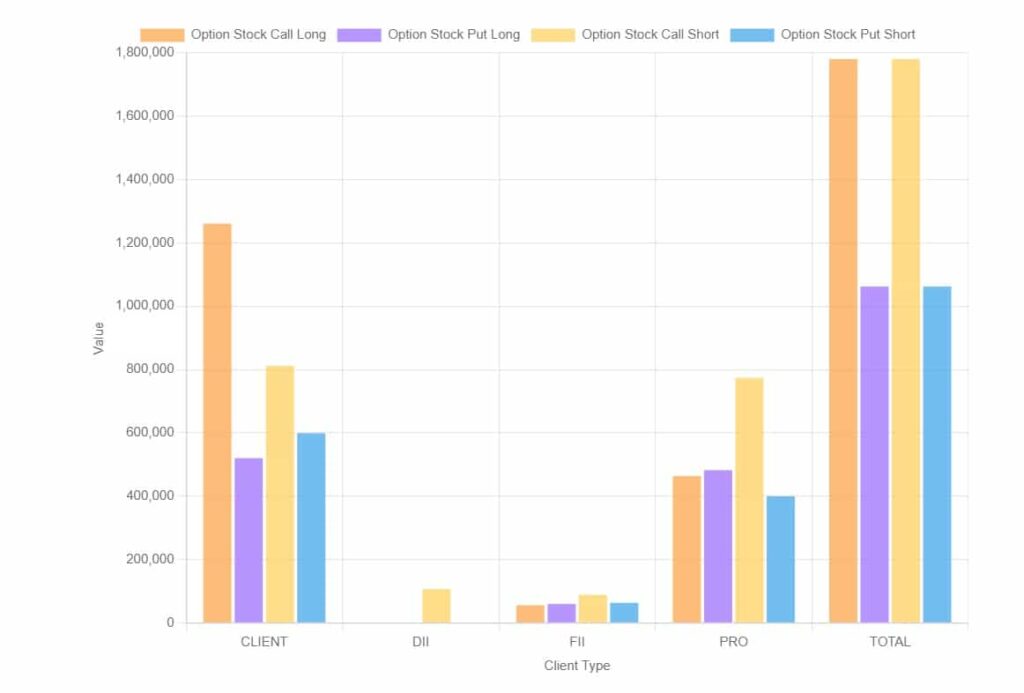Participant Wise Open Interest Charts
Index Future
Stocks Future
Index Options
Stock Options
Total Contracts
Picture this: you’re sitting in your home office, studying the stock market, trying to make sense of the chaos that is derivatives trading. You know there’s a fortune to be made, if only you could decipher the patterns lying just beneath the surface. What if you had a tool at your disposal that could do just that?
Enter Open Interest data – a trader’s secret weapon that’s about to become your best friend. Let’s get this straight, it’s not some magic crystal ball that predicts the market’s every move. Instead, it’s a practical, data-driven approach to understanding the market dynamics hidden beneath the surface of derivative trading.
Open Interest data is like the heartbeat of the derivatives market. It’s the total number of outstanding derivative contracts, such as futures and options, that have not been settled. But how can one harness the power of this raw, unfiltered data? Well, that’s where we come in.
"Open Interest data doesn't just help you understand the market, it helps you anticipate it."
We’ve made it our mission to help traders and investors like you navigate the choppy waters of derivatives trading. We’re here to equip you with the data you need to make informed decisions. The best part? We present this complex data in easy-to-understand charts.
So, sit back, relax, and let us guide you through the fascinating world of Open Interest data. It’s time to elevate your trading game to a whole new level.
Understanding Open Interest
Open interest, in the world of trading, is the total number of outstanding derivative contracts, such as futures and options, that have not been settled. It’s a financial lingo that indicates market liquidity and trading activity. But here’s the catch: To make it work for you, you need to know how to read and interpret this data.
Why Open Interest Data Matters
Open interest data is like a compass guiding you through the rough seas of derivatives trading. It helps in identifying trends and predicting market turns. An increase in open interest signifies that new money is flowing into the marketplace. On the other hand, a decrease in open interest indicates money is leaving.
Reading Open Interest Data
- First, keep an eye out for a rise in open interest along with an increase in price. This indicates that the trend is gaining strength.
- Second, if you notice a decrease in open interest along with a declining price, it’s a signal that the downtrend is likely to continue.
- Third, an increase in price coupled with a drop in open interest could mean the uptrend might be nearing its end.
Remember, the key is to stay vigilant and keep a keen eye on the shifts and swings!
Participants wise Open Interest Data
Now as you now understand that Open interest is a measure of the total number of outstanding contracts in a particular market or security. It is important because it can give you an idea of the overall demand for a particular asset or market. If open interest is increasing, it could indicate that new money is flowing into the market and that there is strong demand for the asset. On the other hand, if open interest is decreasing, it could indicate that traders are closing their positions and that there is weaker demand for the asset.
Fii (Foreign Institutional Investors) and Dii (Domestic Institutional Investors ) open interest can be a useful indicator of the activity of these investors in the market. If Fii open interest is increasing, it could indicate that foreign institutional investors are becoming more active in the market and that they are taking on new positions. This could have implications for the overall direction of the market. Likewise for Dii’s
Data is classified into four categories
1) Client
2) DII
3) FII
4) Pro
Client – Retail trades and HNI (High Networth Individuals) are covered under this category
DII – Domestic Institutional Investors (Banks, Insurance companies, Mutual fund houses)
FII – Foreign Institutional Investors (an investor or investment fund registered in a country outside of the one in which it is investing. Ex: Hedge Funds, Insurance companies, Pension funds, sovereign wealth fund (SWF) etc)
Pro – Proprietary trading (also “prop trading”) occurs when a trader trades stocks, bonds, currencies, commodities, their derivatives, or other financial instruments with the firm’s own money, aka the nostro account, contrary to depositors’ money, in order to make a profit for itself (Source: Wikipedia)
About Fii Dii Data tool

Fii Dii Open Interest Data Tool is a financial market analysis tool that provides EOD data on the open interest of futures and options contracts traded on the National Stock Exchange of India (NSE). It allows users to track the trading activity of Foreign Institutional Investors (FIIs), Domestic Institutional Investors (DIIs), and other market participants.
With the Fii Dii Open Interest Data Tool, users can identify trends and changes in the open interest of various contracts, helping them to make informed investment decisions. The tool also offers a range of technical indicators and charting capabilities to help users analyze market movements and trends. All data is collected from sources considered to be reliable but Please not that the accuracy of data is not guaranteed.
